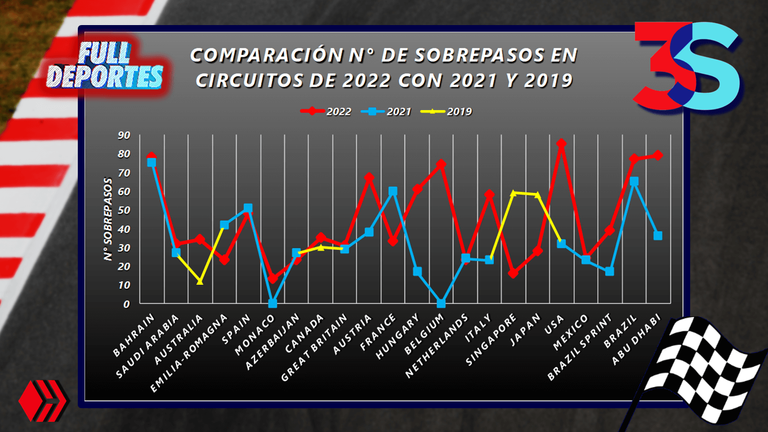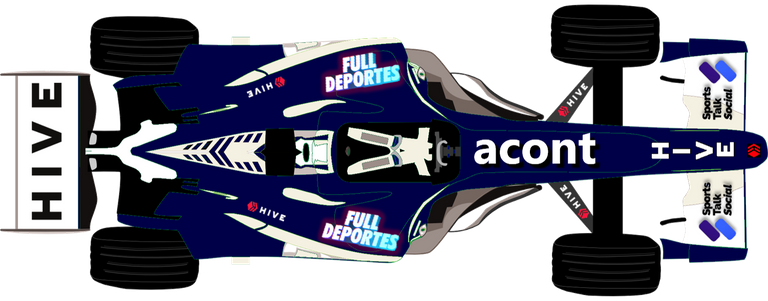En nuestro anterior video de 3Speak, analizábamos acerca de si aumentaron o no los adelantamientos en la temporada 2022 de la Fórmula 1 gracias a la introducción del efecto suelo en los monoplazas de la Fórmula 1. Comentábamos también acerca de si esto realmente repercutió en el espectáculo en sí, más allá de si se aumentaron o no los sobrepasos respecto a 2021.

En este video, quería compartir una gráfica que realicé en Excel tomando en cuenta la data arrojada en este post de Reddit. Esta data cuenta no solo el número de adelantamientos a lo largo de todo el año sino los que se realizaron en cada carrera. Además, también cuenta el porcentaje de dichos adelantamientos que se mostraron en televisión, lo cual es bastante impresionante y minucioso.
En esta gráfica, llegamos a conclusiones bastante interesantes, puesto que hacemos la comparación entre las carreras de 2022 y las carreras de 2021 y 2019. El Gran Premio de Miami fue excluido de esta gráfica porque se estrenó en 2022 y no tiene comparación con años anteriores.
Los Grandes Premios de Australia, Canadá, Singapur y Japón de 2022 se compara con los del año 2019 debido a que no se corrieron ni en 2021 ni en 2020. Sabemos que en 2020 y 2021 la Fórmula 1 corrió en circuitos distintos como los de Qatar, Mugello y Algarve, pero ninguno de estos se corrió en 2022 con el nuevo reglamento por lo que no se puede hacer la comparación.
Este gráfico nos señala que realmente sí hubo un aumento en los adelantamientos en distintos circuitos, pero en algunos se mantuvieron igual o, incluso, se redujeron respecto a años anteriores. En este video de 3Speak para Full Deportes analizaremos esta gráfica para tratar de entrever el efecto, en general, que los cambios de 2022 tuvieron sobre el espectáculo en las carreras.
Gracias por visitar mi blog dedicado al deporta a motor... ¡Hasta la próxima!

In our previous 3Speak video, we discussed whether or not overtaking increased in the 2022 Formula 1 season thanks to the introduction of ground effect in Formula 1 cars. We were also commenting on whether or not this really impacted the show itself, beyond whether or not overtaking was increased compared to 2021.
In this video, I wanted to share a graph I made in Excel taking into account the data from this Reddit post. This data counts not only the number of overtakings throughout the whole year but also those that took place in each race. In addition, it also counts the percentage of such overtaking that was shown on television, which is quite impressive and meticulous.
In this graph, we come to quite interesting conclusions, as we make the comparison between the 2022 races and the 2021 and 2019 races. The Miami Grand Prix was excluded from this graph because it premiered in 2022 and has no comparison with previous years.
The 2022 Australian, Canadian, Singapore and Japanese Grands Prix are compared to 2019 due to the fact that they were not run in 2021 or 2020. We know that in 2020 and 2021 Formula 1 raced at different circuits such as Qatar, Mugello and Algarve, but none of these were run in 2022 under the new regulations so the comparison cannot be made.
This graph shows us that there really was an increase in overtaking at different circuits, but in some circuits it remained the same or even decreased compared to previous years. In this 3Speak video for Full Deportes we will analyze this graph to try to get a glimpse of the effect, in general, that the 2022 changes had on the spectacle of racing.
Thank you for visiting my blog dedicated to motorsports.... See you next time!
Translated to English language with the help of DeepL.com
FuentesSources
Música: Time for Machine (Gvidon) - Pixabay
F1 Overtaking Database 1994-2020 - F1 Overtaking Database 1994-2020
Programa de Edición: Filmora. Grabado mediante Redmi 9C.
 |
 |
Otras redes sociales:
 |
 |
 |
 |
| ¡Gracias por visitar! — Deja tu comentario 🚥🏆  |
▶️ 3Speak